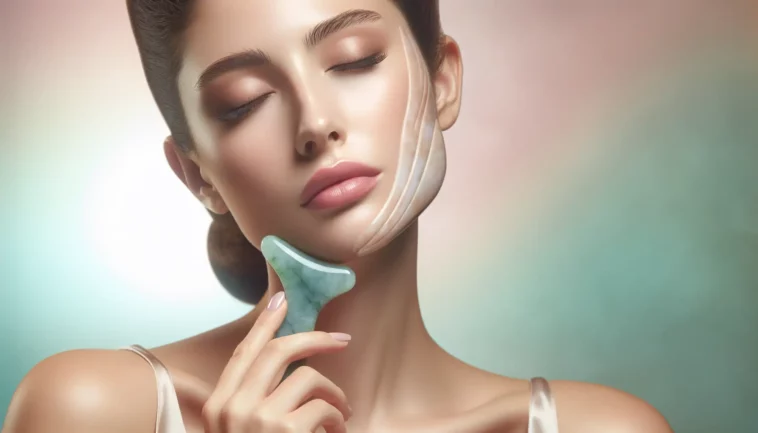To use a gua sha stone, the right technique is crucial. This guide, “How to use a Gua Sha stone,” cuts through the noise to provide clear, actionable steps for a Gua Sha facial massage that aims to improve blood flow and reduce puffiness. No fluff, just the essentials you need to make this traditional tool work for your skincare goals.

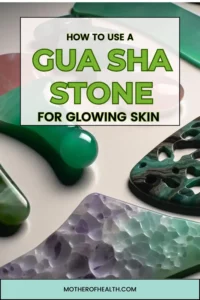
Essential Insights
- Gua Sha is an ancient Chinese technique, used for improving health and skin quality by gently scraping the skin to promote energy flow and toxin release
- Choosing the right Gua Sha tool is crucial; it should be smooth, easy to handle, and made from materials like jade or rose quartz for their cooling and circulation-improving properties
- Regular use of a Gua Sha in your skincare routine can enhance circulation, promote lymphatic drainage, diminish puffiness, and potentially contour facial features if done with the correct technique and pressure.
Unlocking the Secrets of Gua Sha
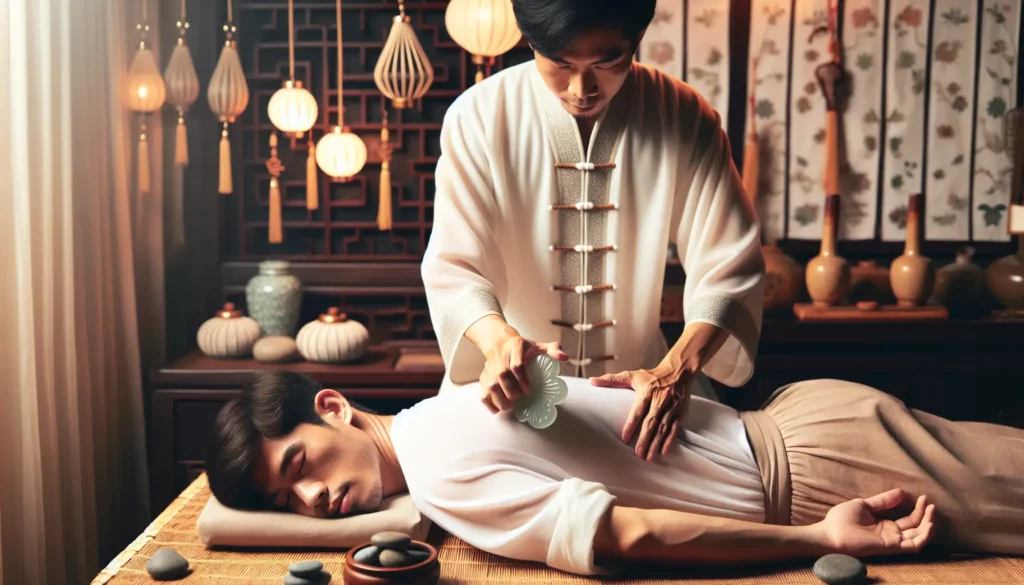
Gua Sha has deep roots in Chinese culture, dating back to the Paleolithic age. It's a tradition handed down through generations. The Ming Dynasty's major medical records also highlight Gua Sha's long history.
Initially, Gua Sha therapy used tools made from natural materials like buffalo horn. Over time, various smooth-edged instruments have become part of the practice.
At its heart, Gua Sha is linked to the concept of Qi in Traditional Chinese Medicine. The techniques aim to clear Qi blockages. This balances the yin and yang forces.
Originally, Gua Sha was for full-body healing, aiding in recovery and toxin removal. Today, it has evolved. Modern Gua Sha focuses more on facial treatments to enhance beauty and well-being.
The Name ‘Gua Sha'
The term ‘Gua Sha' reflects its core philosophy. ‘Gua' means scraping, and ‘sha' points to the redness that shows toxins leaving the body.
Gua Sha is known for its health benefits. It helps release tension, boosts circulation, and calms the nervous system. Adding Gua Sha to your daily beauty routine can be very beneficial. Learning about Gua Sha can greatly improve your well-being.
Selecting the Perfect Gua Sha Tool
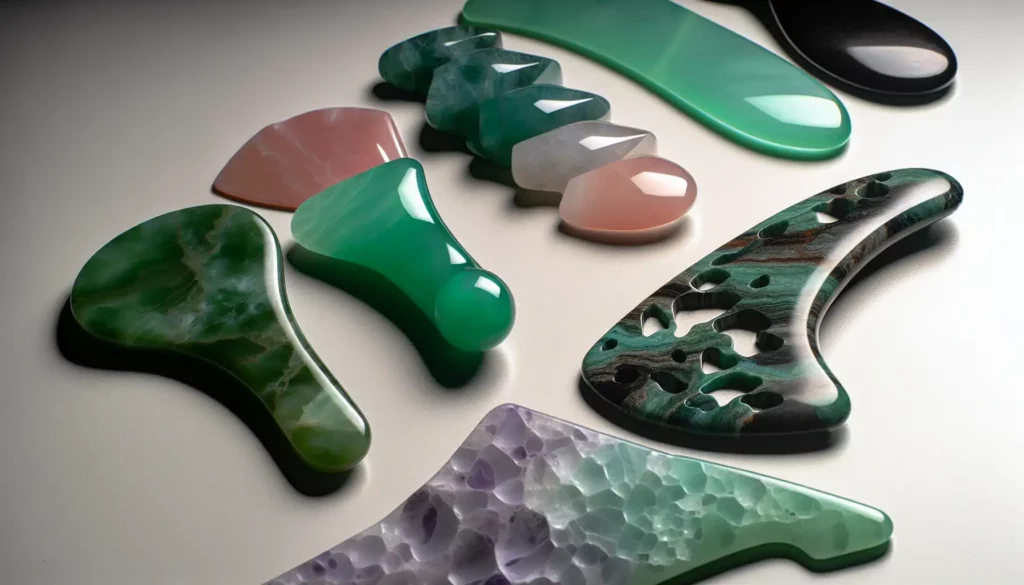
As you embark on your journey to master the art of facial gua sha, the selection of the perfect tools is a key step. Some popular choices for high-quality gua sha tools are:
- Jade Stone Gua Sha Massage Tool
- Rose quartz with a unique Comb Edge
- The YINA Bian Stone Gua Sha tool, made of bian stone known for its therapeutic properties, is valued for its larger surface and four distinct edges.
Regardless of the stone type, the ideal gua sha tool should have:
- a smooth and rounded shape
- comfortable grip
- varying contours suitable for different facial areas
- antimicrobial qualities
- a natural cooling effect
Jade and quartz are preferred materials for modern gua sha tools, used to improve blood circulation and relieve pain and tension. Moreover, choosing the right gua sha stone involves supporting brands that respect the tool's medicinal, cultural, and historical significance.
Preparing Your Skin for Gua Sha
Before starting the gua sha process, it's essential to prepare your skin properly.
Start with a clean face to set the stage for an effective gua sha facial massage. This helps with the absorption of oils and enhances the benefits of the treatment. To avoid irritation and get your skin ready for gua sha, use a gentle facial mist or an alcohol-free toner to hydrate your skin.
It's also vital to choose the right facial oil. Look for one that's hydrating, safe (without any harmful ingredients), and allows for smooth movement of the gua sha stone across your face.
Now, let's explore these two key steps of skin preparation in more detail.
Importance of Clean Skin
To prevent pushing dirt or bacteria deeper into the pores, which could lead to potential breakouts or irritation, it's essential to start a gua sha session with clean skin. Clean skin allows the gua sha tool to glide smoothly, maximizing the therapeutic benefits of the massage technique.
However, remember that gua sha should not be used on damaged skin such as areas with rashes, bruises, sunburns, cuts, or active acne to prevent aggravation and additional skin issues.
Choosing the Right Facial Oil
When using gua sha, it's important to choose a facial oil that aligns with your skin type. If you have oily skin, opt for lighter oils, and if your skin is dry, go for richer formulations. Some options for facial oils include:
- Jojoba oil: A universal choice for gua sha massage, as its composition is similar to the skin's natural oils and suitable for all skin types.
- Rosehip oil: Great for hydrating and brightening the skin
- Argan oil: Rich in antioxidants and fatty acids, it helps nourish and moisturize the skin
- Marula oil: Known for its anti-aging properties and ability to improve skin's elasticity
It's also essential to choose facial oils that are packaged in dark glass bottles with a dropper or pump dispensers to protect the oil from light and air, preserving its beneficial properties.
Applying a high-quality Ayurvedic facial serum before gua sha can help to drive the serum's potent ingredients deeper into the skin for enhanced efficacy.
How To Use a Gua Sha Stone: A Step-by-Step Tutorial
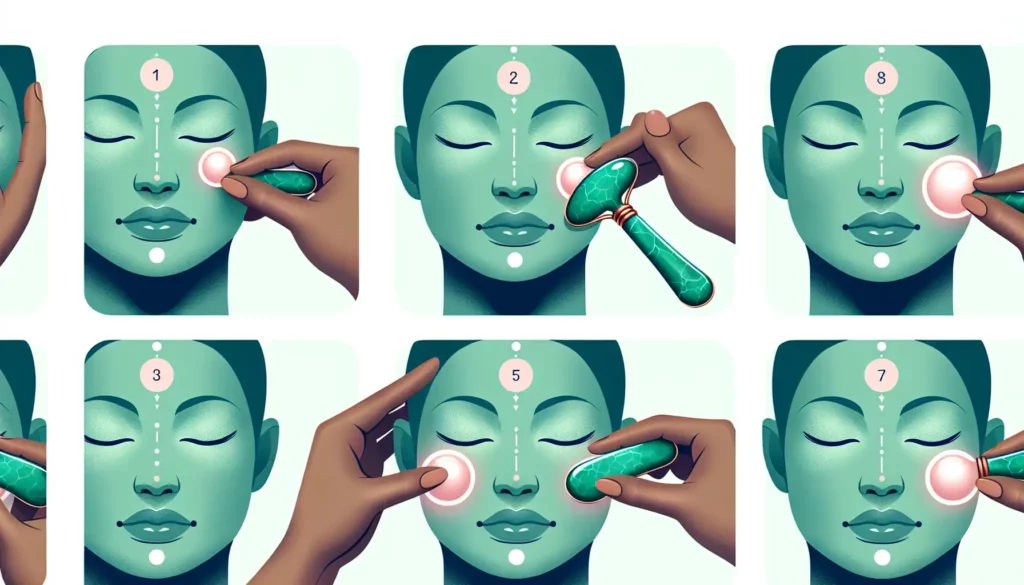
After preparing your skin properly, you're ready to begin the gua sha process by refining your technique. Hold the gua sha tool almost flat against your skin, maintaining a consistent, gentle pressure throughout the massage.
Gua sha helps boost blood flow in the skin, leading to a brighter and more vibrant complexion. For areas like the neck and shoulders, use the tool in gentle upward and downward motions, respectively.
Typically, a gua sha facial massage lasts about 10 minutes. During this time, you can also use techniques to massage and roll the neck and define the jawline, preferably with a cooled tool to aid in lymphatic drainage.
Learning gua sha may seem challenging at first, but by focusing on the gentle application, the right angle, and the correct direction of the strokes, it becomes more manageable. Let's explore these techniques in more detail.
Gentle Pressure and Angle Mastery
The key to effective gua sha lies in the balance between the correct angle and gentle pressure. The gua sha tool should generally be held at a 15 to 45-degree angle to the skin, where 15 degrees is used with light pressure and a flatter hold, and 30 to 45 degrees allows for precise use of the tool’s edge.
Apply gentle pressure using the flat side of the tool, pressing firmly but not too hard, supporting tissue drainage without causing damage or bruising.
Achieving therapeutic benefits and promoting the smooth flow of qi necessitates the mastery of both the correct angle and gentle pressure during gua sha application by a traditional Chinese medicine practitioner.
Direction is Key
The direction of the strokes is another crucial aspect of gua sha technique. Proper gua sha technique stimulates the lymphatic system, eliminates water retention, and helps release fluids and toxins. Gua sha movements should be:
- Gentle
- Light
- Slow
- Rhythmic
- Nurturing
- Mirroring the natural cadence of the lymph flow
Starting a gua sha session from the neck helps with overall circulation and releases tight muscles affecting the face. Movements should be upwards and outward, beginning from the central areas of the face and neck towards the periphery. Guide the gua sha tool towards lymph nodes to enhance the detoxifying effect, leading to a decrease in puffiness.
Sculpting Your Features with Gua Sha Tools
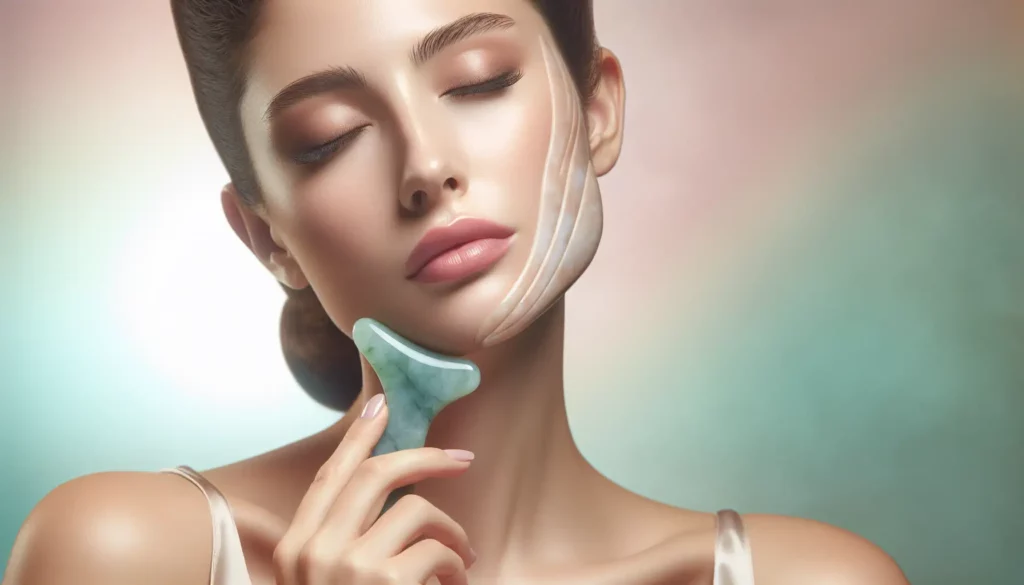
Facial Gua Sha isn’t just about improving skin health; it’s also a powerful tool for sculpting your facial features. The variety of angles, curves, and lengths on the edges of gua sha tools allows for targeted sculpting of different facial areas like the jawline and cheekbones.
Using tools like the Gua Sha Facial Lifting Tool and the Acupressure Gua Sha Spoon can aid in defining facial features and releasing tension in the jaw and facial muscles.
Regular and proper use of gua sha promotes lymphatic drainage, decreases inflammation, brightens the complexion, and has the potential to contour facial muscles. Additional benefits include improved movement of lymphatic fluids, reduction of facial lines, increased blood circulation, firmer skin, and reduced hyperpigmentation.
Now, let’s explore how to use gua sha to define the jawline and cheekbones and soothe the brow bone and forehead.
Defining the Jawline and Cheekbones
Gua sha can miraculously define your jawline and cheekbones. To define the jawline, start by gliding the tool upwards from the center of the chin out to the earlobe, following the contour of the jaw. You can use the curved side of the gua sha stone to draw slow strokes, massaging from the chin up to the ear. This technique can help promote circulation and relax the facial muscles..
For contouring cheekbones, begin at the nose and work upwards in a sweeping motion along the cheeks and cheekbones, moving outwards toward the ears. Repeat the motion several times for each section.
Soothing the Brow Bone and Forehead

Besides defining facial features, gua sha can also soothe the brow bone and forehead.
To relax the brow area, start by gently moving the gua sha stone upward along the brow bone, from the inner corner outward.
Reduce tension around the brow bone by beginning at the hairline above the eye and softly dragging the gua sha stone backward, mimicking a combing motion, while ensuring the stone remains flat against the skin.
To relieve tension in the forehead, you can use a gua sha stone.
Here’s how:
- Glide the flat end of the gua sha stone from the brow line up to the hairline, focusing on the third eye area just below the brow.
- Divide the forehead into three sections.
- Starting at the center, use the gua sha tool to glide outwards for each section.
- Move down slightly after each pass.
Integrating Gua Sha into Your Skincare Routine

Having become well-versed in the gua sha technique, you can now incorporate it into your skincare routine. Gua sha can be effortlessly incorporated into a nightly facial routine as recommended by experts like Chiu. The gua sha tool is versatile for use in both short and extended sessions, depending on your personal preference and time constraints.
Consistently incorporating gua sha into your weekly regimen aids in maintaining its benefits over time. You can simplify the transition by using sets like Pink Moon’s Over the Moon Duo, which includes a gua sha tool and a complementary facial oil.
How Often To Use Gua Sha
The frequency of gua sha use is largely dependent on your skin type and its reaction to the treatment. Starting with once a week can be a good initial frequency, which can then be adjusted based on your skin’s response. Experts like Lam recommend using gua sha at least a few times a week, while Chiu advocates for daily use to maximize benefits.
For targeted goals such as reducing the appearance of a double chin, consistent gua sha use may lead to a more defined neck and chin contour. One of the greatest advantages of gua sha is its flexibility, as it can be practiced at any time that suits your routine.
Post-Gua Sha Care
To maintain healthy skin, diligent care after a gua sha session is essential. Here are some steps to follow:
Apply moisturizer and facial oil after the gua sha massage to refresh, moisturize, and protect the skin barrier.
Rosehip oil, rich in omega-3, omega-6, and fatty acids, is recommended post-gua sha for its hydrating qualities and potential to soften skin and reduce the appearance of scars and fine lines.
Sealing the skin with facial oil after gua sha can support and protect the skin barrier while providing additional nourishment.
Applying eye cream after using a gua sha tool and following up with a de-puffing eye massage can reduce puffiness and enhance the cream’s absorption. Completing your usual skincare routine after gua sha, including the application of eye cream and other products, helps lock in the benefits of the massage.
Addressing Common Concerns and Misconceptions
In light of its growing popularity, it’s important to address some common concerns and misconceptions surrounding gua sha. Contrary to popular belief, facial gua sha, when performed correctly with light strokes, is not painful and should not cause significant skin irritation. Temporary skin redness and slight bruising, such as petechiae that fade in a few days, are possible side effects, but deliberate bruising associated with body gua sha does not typically occur in facial gua sha.
In contrast to traditional gua sha, which is more aggressive and can result in bruising, facial gua sha uses slower techniques with much less pressure and aims for a therapeutic and rejuvenating effect on the skin. The immediate benefits of facial gua sha include relief from headaches, sinus congestion, and a tight or painful jaw, contradicting any misconception that gua sha provides no tangible results.
Special Considerations and Contraindications
Despite the general safety of gua sha, there exist certain conditions warranting caution or completely avoiding its use. Gua sha should be avoided by individuals with:
- sunburn
- active breakouts
- blood coagulation issues
- recent surgery
- severe acute medical condition
- high fever
This is to ensure their safety and prevent any potential harm.
People with the following conditions should avoid gua sha:
- Presence of a tumor
- Thin skin
- Taking prescription blood thinners
- Clotting disorders
Performing gua sha on unclean skin can spread bacteria, increasing the risk of infections, particularly if there are open wounds or sensitive areas. It’s always best to consult with a healthcare professional if you have any concerns before starting gua sha.
Summary
To wrap things up, gua sha is a powerful tool rooted in Traditional Chinese Medicine that can revolutionize your skincare routine. From selecting the perfect gua sha tool to mastering the technique and seamlessly integrating it into your skincare routine, we’ve covered everything you need to embark on your gua sha journey. Whether you’re looking to enhance your complexion, sculpt your facial features, or simply adopt a therapeutic self-care practice, gua sha offers a myriad of benefits. So, are you ready to experience the magic of gua sha?
Frequently Asked Questions
Do gua sha stones really work?
Yes, gua sha stones can work for some people, providing noticeable, though not permanent, results such as relief from TMJ symptoms. Give it a try and see how it works for you!
How long does it take to see results from a gua sha stone?
You should start seeing results within a week of using a Gua Sha stone twice daily. Gua Sha facial massages can also have other health benefits like boosting the immune system and improving blood flow and circulation.
How to use gua sha?
To use gua sha, hold the tool at a 30 to 45-degree angle, gently pull it across your skin, making upward movements following the lymphatic flow, and repeat each movement three to five times before moving to the next area of your skin.
How often should I perform gua sha?
Start with once a week, then adjust based on your skin's response. Use gua sha a few times a week for best results.
Can gua sha be painful?
No, when done correctly with gentle strokes, facial gua sha should not be painful and should not cause skin irritation.
Related Content:
Simply Earth Essential Oils Review
Benefits of a Liver Cleanse – Turn Your Body Into a High Performing Machine
The 12 Most Sought After Healing Crystal Stones and Their Properties To Improve Your Life
Turmerisa Double Turmeric – Facial Essence Review
These 7 Tips Will Show You How to Remove Bags Under Your Eyes Naturally

